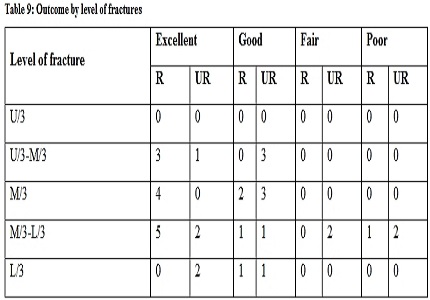Study To compare and assess the clinical results of interlocking nailing in closed fractures of shaft of tibia by reamed and unreamead technique
Abstract
Introduction: The successful use of unreamed nailing in patients with open tibial fractures has led some investigators to recommend this technique for closed fractures as well. Potential advantages of unreamed nailing over the reamed technique include shorter operative time, less blood loss and less disruption of the endosteal blood supply in patients with severe closed soft tissue injuries.
Materials and Methods: This study consists of 34 cases of fracture both bones of leg, tibia treated by internal fixation with interlocking tibia, of which 17 cases are reamed and 17 cases are unreamed from August 2009 to July 2011, and followed upto November 2011. The study was conducted to assess the functional outcome and complications of reamed over unreamed nailing in tibial fractures.
Results and Conclusion: In our study group there are no definitive criteria for using reamed and unreamed procedures, age groups are comparable and both procedures are applied randomly. 2 superficial infections are noted in unreamed cases and one deep infection noted in reamed cases. Knee pain complained in two cases of reamed nailing compared to one case of unreamed nailing. Odema of leg noted in one case of unreamed nailing. Earliest union noted in reamed nailing compared to unreamed.
Downloads
References
2. Frink M, Hildebrand F, Krettek C, Brand J, Hankemeier S. Compartment syndrome of the lower leg and foot. Clin Orthop Relat Res. 2010 Apr;468(4):940-50. doi: 10.1007/s11999-009-0891-x. Epub 2009 May 27. [PubMed]
3. Duwelius PJ, Schmidt AH, Rubinstein RA, Green JM. Nonreamed interlocked intramedullary tibial nailing. One community's experience. Clin Orthop Relat Res. 1995 Jun;(315):104-13. [PubMed]
4. Gregory P, DiCicco J, Karpik K, DiPasquale T, Herscovici D, Sanders R. Ipsilateral fractures of the femur and tibia: treatment with retrograde femoral nailing and unreamed tibial nailing. J Orthop Trauma. 1996;10(5):309-16. [PubMed]
5. Keating JF, O'Brien PJ, Blachut PA, Meek RN, Broekhuyse HM. Locking intramedullary nailing with and without reaming for open fractures of the tibial shaft. A prospective, randomized study. J Bone Joint Surg Am. 1997 Mar;79(3):334-41.
6. Gregory P, Sanders R. The treatment of closed, unstable tibial shaft fractures with unreamed interlocking nails. Clin Orthop Relat Res. 1995 Jun;(315):48-55. [PubMed]
7. Browner BD, Wiss DA: GK locking nail for the femur. The science and practice of intramedullary nailing. Philadelphia, Lee and Febyer, 1987'.
8. Whittle AP, Russell TA, Taylor JC, Lavelle DG. Treatment of open fractures of the tibial shaft with the use of interlocking nailing without reaming. J Bone Joint Surg Am. 1992 Sep;74(8):1162-71.

Copyright (c) 2015 Author (s). Published by Siddharth Health Research and Social Welfare Society

This work is licensed under a Creative Commons Attribution 4.0 International License.


 OAI - Open Archives Initiative
OAI - Open Archives Initiative


